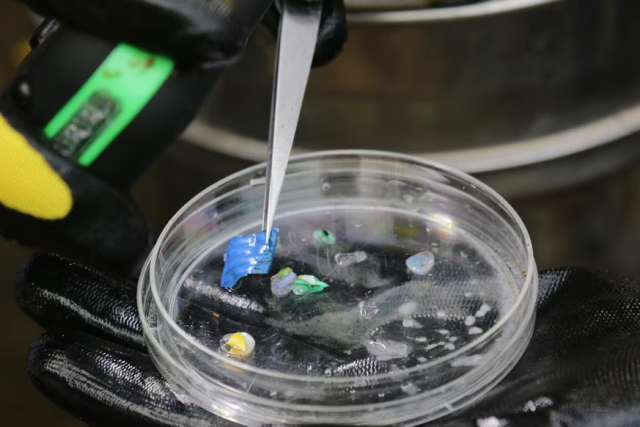Puerto Rican scientific community promotes innovation against microplastics
Submitted on 24 August 2023 - 3:42pm
This article is reproduced by CienciaPR with permission from the original source.
CienciaPR Contribution:
Original Source:
By:

Although these tiny particles continue to contribute to the water pollution problem, local researchers are exploring new solutions.
"These are everyday sights in Puerto Rico today," said Jorge Bauzá, pointing to photos of piles of plastic bottles, garbage bags and foam coolers piled up on idyllic beaches.
"We still have a long way to go to change this plastic culture," emphasized the oceanographer and scientific director of the San Juan Bay Estuary Program, during the annual conference of the Puerto Rico College of Chemists -PR Chem- held recently.
A glance around the room where he was speaking confirmed his statement. Attendees held plastic pens, drank water from plastic cups and wore synthetic fiber cords around their necks.
With a diameter of less than 5 millimeters, microplastics are tiny particles, but with significant impact. They come from synthetic textiles, tires, household waste and paint, among other sources, and reach bodies of water through industrial spills, storms or shipping.
A 2021 publication from the University of Puerto Rico Rio Piedras Campus examined sand from six beaches on the island's north coast, finding a variety of microplastics in each sample. The amount seemed to vary depending on the beach's degree of urbanization, its connection to watersheds and creeks, and its industrial activity, but all showed a high level of contamination. "We have a higher level compared to other islands in the Caribbean," noted Bauzá, who was not affiliated with the study.
:format(jpeg)/cloudfront-us-east-1.images.arcpublishing.com/gfrmedia/AMXCU3QITBAO3E5UZSS4VYGQSU.jpg)
Other research, published in 2020 by Inter-American University scientists, found between 5,000 and 15,000 microplastic particles per square kilometer in parts of the San Juan Bay estuary.
When microplastics hit the water or beaches, they are here to stay. Microplastics take hundreds to thousands of years to decompose. Fish, birds and other marine species ingest these particles, mistaking them for food because of their bright colors.
Because of their structure, microplastics act "like a sponge that tends to absorb pollutants," Bauzá explained. They easily absorb and release toxic chemicals, such as phthalates, polyvinyl and bisphenol A, which are associated with hormonal disorders and cancer.
It is estimated that each person consumes between 78,000 and 211,000 microplastic particles per year, which has a largely unknown effect on health.
Due to the severe effects of microplastics, the scientific community has taken it upon itself to develop techniques to combat their origin and spread.
Bioplastics, for example, are materials made from sugar cane, corn or other plants that decompose with sunlight, heat and oxygen. They can replace plastic in the manufacture of bags, cutlery and cups, among other things. However, "bioplastics only degrade under certain conditions and are expensive to produce," admitted Bauzá.
Another technique involves the use of buckets connected to water pumps that can collect floating plastics and microplastics. There are installations of this type in the Cayman Islands, Jamaica and the United States. "In Puerto Rico, I haven't seen such an installation," Bauzá said. "In the Estuary, we tried to do the management, but it was never taken up."
Additional techniques include bacteria that can metabolize plastic, magnetic liquids that trap microscopic particles, and aerogels that submerge microplastics, but these "are more in a design stage," he acknowledged.
While these and other techniques continue to be explored, Puerto Rico implemented Law 51-2022 to prohibit the sale and use of single-use plastics. The law will take effect on June 1, 2024 and could reduce the amount of microplastics generated in the country.
:format(jpeg)/cloudfront-us-east-1.images.arcpublishing.com/gfrmedia/5USGLGONIZF5ND733JMXROXTWU.jpg)
But, "the effect is not going to be that fast," Bauzá pointed out. "This is not going to disappear overnight."
He argued that the microplastics problem requires the collaboration of researchers to study the feasibility of new technologies for Puerto Rico, private companies to fund the efforts, and the public to decrease their consumption of plastics.
"We scientists have a social responsibility," Bauzá said. "We have to educate the community, make science available to the community."
With him, agreed Victor Adorno Badillo, president of the College, who led the conference. "This is what we intend: through chemical knowledge, to give awareness (to the community) of how important it is for the environment," he stressed.
The author studies biology and is a scholar of the American Association for the Advancement of Science at El Nuevo Día.







